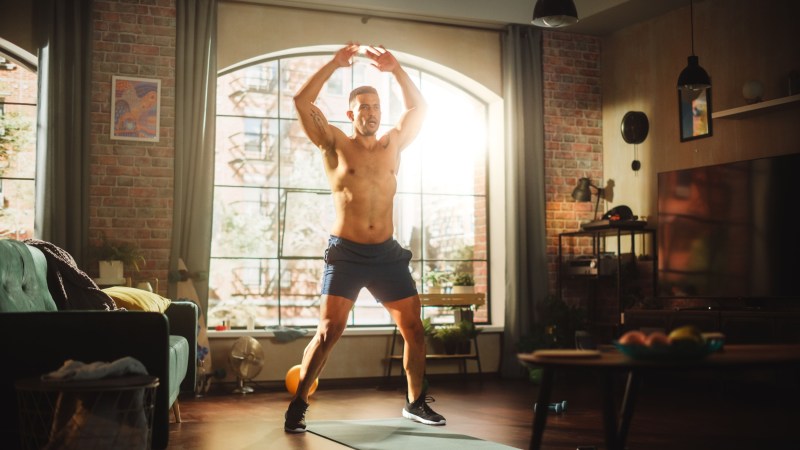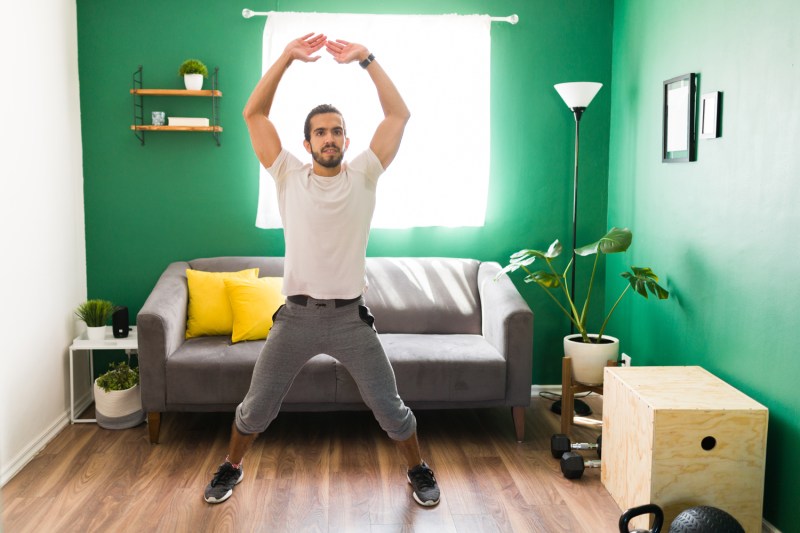Each branch of the armed forces uses a simple bodyweight exercise to keep everyone in peak physical condition — they clearly understand the benefits of jumping jacks! While exercises like squats, pushups, and pullups have their own benefits, jumping jacks can take a workout to a whole different level.
It might be a decade or more since you last did a round of jumping jacks, but this childhood favorite calisthenic exercise is not just child’s play — jumping jacks have plenty of health and fitness benefits for adults. When I started doing jumping jacks again after a few years, I loved the feeling of the increase in circulation, the endorphins, and just getting my muscles moving in a childlike way, so I kept going until I was out of breath.
Jumping jacks are easy to perform, require no equipment, and have the unique perk of bringing back nostalgic memories, making them feel as much like play as a workout. Here’s your guide to jumping jacks, including the benefits, the muscles worked, variations to try, and more.
What are jumping jacks?

Jumping jacks or star jumps are a versatile aerobic bodyweight exercise often used in plyometrics, calisthenics, jump training, warmups, and workout circuits. It involves starting in a standing position and hopping your feet out until your feet are about shoulders-width apart while simultaneously bringing your arms out to the sides and up over your head. You hop your feet back together to the starting position while lowering your arms back down to your sides.
What muscles do jumping jacks target?

The primary muscles worked the most are your glutes, quads, and hip flexors. Jumping jacks target your:
- Quadriceps at the front of your thighs
- Hamstrings at the back of your thighs
- Glutes
- Hip abductors and adductors
- Calves
You’ll also stabilize your core and engage core muscles like your rectus abdominis, obliques, and transverse abdominis.
As you raise and then lower your arms, you’ll target:
- Deltoids in your shoulders
- Trapezius muscles in your upper back
- Pectorals in your chest
- Biceps in your upper arms
- Lat muscles below your shoulder blades
How to do jumping jacks

How to do jumping jacks with proper form:
- Stand with an upright torso with your feet together and your arms straight down by your sides.
- Bend your knees and jump up while moving your legs out to the sides and raising your arms out to the sides and up overhead. These movements happen simultaneously.
- After you land, jump back to the starting position by bringing your feet together and lowering your arms down to your sides.
How many repetitions should you do?

How many reps you should do depends on your goals and fitness level. Most people start at a lower to moderate intensity before picking up the pace and powering through faster repetitions to really get the heart pumping. If you’re doing jumping jacks as part of a workout circuit or warmup, aim for 2 or 3 sets of 10 or more repetitions. Some advanced athletes or people who are more active might do 100 repetitions of jumping jacks spread across multiple sets in a single session.
Tips for performing jumping jacks safely

Jumping jacks are a simple exercise, but keeping these basic safety tips in mind can help you reduce your risk of injury:
- Make sure you’re on stable ground. A flat, even surface works best.
- Wear supportive shoes like athletic sneakers rather than boots or sandals.
- Try to warm up your muscles with some light aerobic activity or dynamic stretching movements before diving right into reps and reps of jumping jacks.
- Remember to keep your core engaged and your chest up.
- With every jump, try to make sure you’re landing softly on the balls of your feet.
- Try to make sure your body forms the shape of an X at the top of the jump. Your arms and legs make up the lines of the letter X.
- Aim to rest at least 30-60 seconds in between sets.
- You can add reps and sets over time as you become more familiar with the exercise and advance your fitness level.
- Muscle soreness after working out is normal, but you shouldn’t feel any sharp, sudden, or severe pain. Always listen to the signals from your body.
Experienced fitness trainers like Nick Tumminello share tips on how to safely land softly on your feet with proper form and how to prevent stiffness in your ankle joints. Working with a personal trainer or physical therapist gives you professional guidance for your workout plan.
What are the benefits of jumping jacks?

Jumping jacks give you a solid leg workout and can be adapted to suit all fitness levels. Advanced athletes often perform power jacks, which is a squat followed by a jumping jack of maximum height. Jumping jacks can boost your stamina and cardiovascular health, improve core strength and posture, and more.
Regular aerobic exercise can help with weight management, reduce blood pressure, and improve cholesterol and insulin sensitivity. Read on for 12 benefits of jumping jacks.
1. Jumping jacks improve cardiovascular fitness

Jumping jacks increase heart rate and respiration and challenge your cardiovascular system. Completing extended sets of jumping jacks and progressing the duration of your sets will improve your aerobic fitness and endurance. Aim to move as fast as you can with good form, completing the full range of motion with each jump. Start with sets of 30 seconds and build up to several minutes or more without stopping.
2. Jumping jacks build leg strength

Jumping jacks work all the major muscles in your lower body, strengthening your glutes, hamstrings, quads, hips, calves, and shins. The higher and faster you jump, the more power and strength you’ll develop. You can also wear a weighted vest to increase the intensity and load. Building leg strength through jumping jacks can also help you improve your deadlift, squat, vertical jump, running speed, and ability to climb stairs.
3. Jumping jacks are a total-body exercise

With this move, you’ll work nearly every major muscle in your body, including your legs, arms, shoulders, chest, back, and abs. Jumping jacks are an excellent exercise to incorporate into a warm-up routine because they increase your heart rate and circulation to your muscles and connective tissues, preparing them for more demanding exercise. It’s an excellent dynamic stretching move for your hips, shoulders, and back.
4. Jumping jacks burn calories

You don’t have to run a marathon or stride along on an elliptical trainer for an hour to torch a significant number of calories. Regularly incorporating vigorous sets of jumping jacks may support fat loss, especially with a healthy diet and a well-rounded, total-body workout routine.
5. Jumping jacks increase bone density

Jumping jacks are a form of plyometrics or explosive jump training that involves impact landing. Like other high-impact activities such as running, jumping jacks stimulate your bones to lay down new bone cells and a denser matrix of minerals to withstand the stress. Research shows jumping exercises like jumping jacks increase bone density, which reduces the risk of fractures, particularly as you age.
6. Jumping jacks improve mobility

Jumping jacks move several of your joints close to their full range of motion, which promotes mobility. For example, your hips and shoulders both abduct and adduct (move out to the side and back) in the frontal plane, a direction not well represented in most exercises. Maintaining mobility in these joints minimizes your risk of injury and reduces stiffness and discomfort.
7. Jumping jacks increase hip strength

Jumping jacks are a form of lateral training, which is important in building an injury-resistant body. The motion is side to side rather than front to back, which helps you strengthen different hip muscle fibers that you don’t fully engage when walking and other activities. Regularly performing jumping jacks balances the strength around your hip joints and enhances lower body strength, lowering your risk of injuries.
8. Jumping jacks improve coordination

Jumping jacks look simple enough, but they require a fair amount of coordination, making them great for your brain and improving balance and rhythm.
9. Jumping jacks are great for HIIT workouts

Exercises that quickly elevate your heart rate and involve multiple muscle groups work well for HIIT workouts because they can be strung together quickly in a challenging workout. Interspersing jumping jacks in a HIIT workout pushes your body to keep working at a high intensity.
10. Jumping jacks can be done anywhere

Jumping jacks are a versatile exercise you can perform pretty much anywhere you have a foot of space. They’re more accessible because you don’t need a gym membership or equipment.
11. Jumping jacks reduce stress

Feeling stressed at work? Roll your chair aside for a minute and bang out a set of jumping jacks. Like most exercises, jumping jacks can decrease cortisol levels and reduce stress and tension.
12. Jumping jacks are fun

Maybe it’s the nostalgic memories of playground fun or the rush of endorphins that comes from heart-pumping, total-body exercise, but you’ll probably experience a boost in your mood with a round of jumping jacks.
Jumping jack variations

If you want to mix it up, or if the regular jumping jacks start to get boring, there are countless ways to change the exercise and keep things interesting. Try the following jumping jack variations:
- Sidestep jack – The sidestep jack is an effective alternative to jumping that might appeal to those with knee pain or injury. As your arms go up over your head in the jack motion, step one of your feet a few feet to the outside. Then, as your arms come back down, bring the leg back to the center. As your arms go up the next time, repeat the motion with your other leg.
- Burpee jumping jacks – Burpee jumping jacks combine the two exercises. When coming from a spread jumping jack to standing straight up, drop down and do a burpee. Then, on your spring back up, add a jumping jack before you go back down for your next burpee.
- Jump rope jack – As the rope comes down, hop over it, splitting and rejoining your legs on each jump like a jumping jack.
- Squat jack – Start standing with your arms down by your sides and your feet together. Jump both feet into a wide squat and touch the ground between your feet as you land. Your knees should be just over your toes. Jump up vertically and bring your feet back together to the starting position. Repeat the move and touch the ground with your other hand.
FAQs

What are the benefits of jumping exercises?
Jumping exercises like jumping jacks help move your lymphatic system, promote weight loss, help you jump higher, boost your functional fitness, and more.
What do 100 jumping jacks a day do?
Performing 100 jumping jacks a day will enhance your overall fitness and help you torch calories.
Can jumping jacks reduce belly fat?
Reducing belly fat requires the right nutrition, hormonal balance, and other factors. As a form of aerobic exercise that raises your heart rate, jumping jacks can help promote weight loss and body fat loss, including around the abdominal area.
Can you do jumping jacks every day?
You can perform jumping jacks every day, and the right number for you depends on your goals and fitness level. Most professional fitness trainers and health experts suggest including rest days and switching up your workout routine with other exercises every so often.
How to incorporate jumping jacks into your workout routine

Jumping jacks are a versatile exercise to add to a warmup, a HIIT workout, circuit training, full-body workouts, and more. Throw a few sets of star jumps into a strength training routine for a cardio boost. You can also just go for a round of jumping jacks whenever you feel the need to get your muscles moving and your heart pumping.




